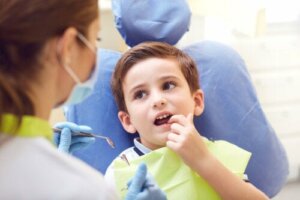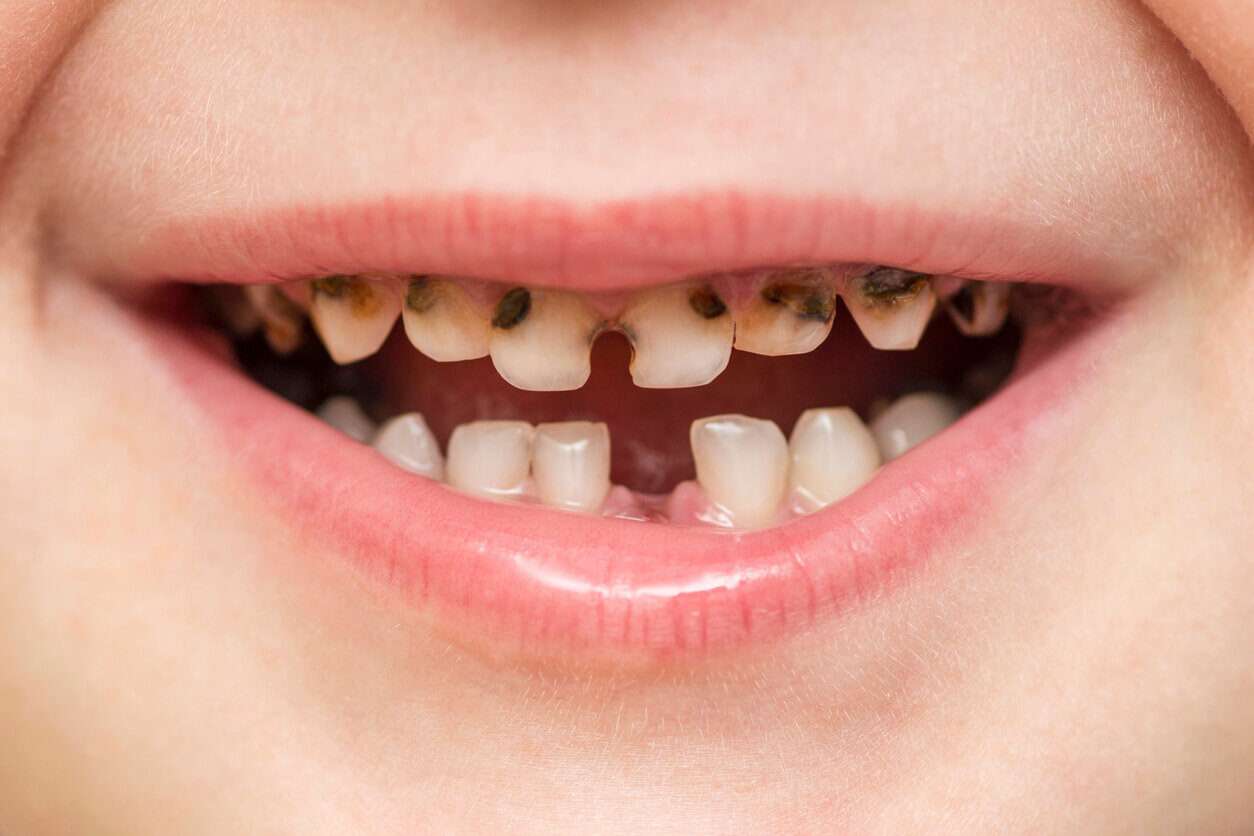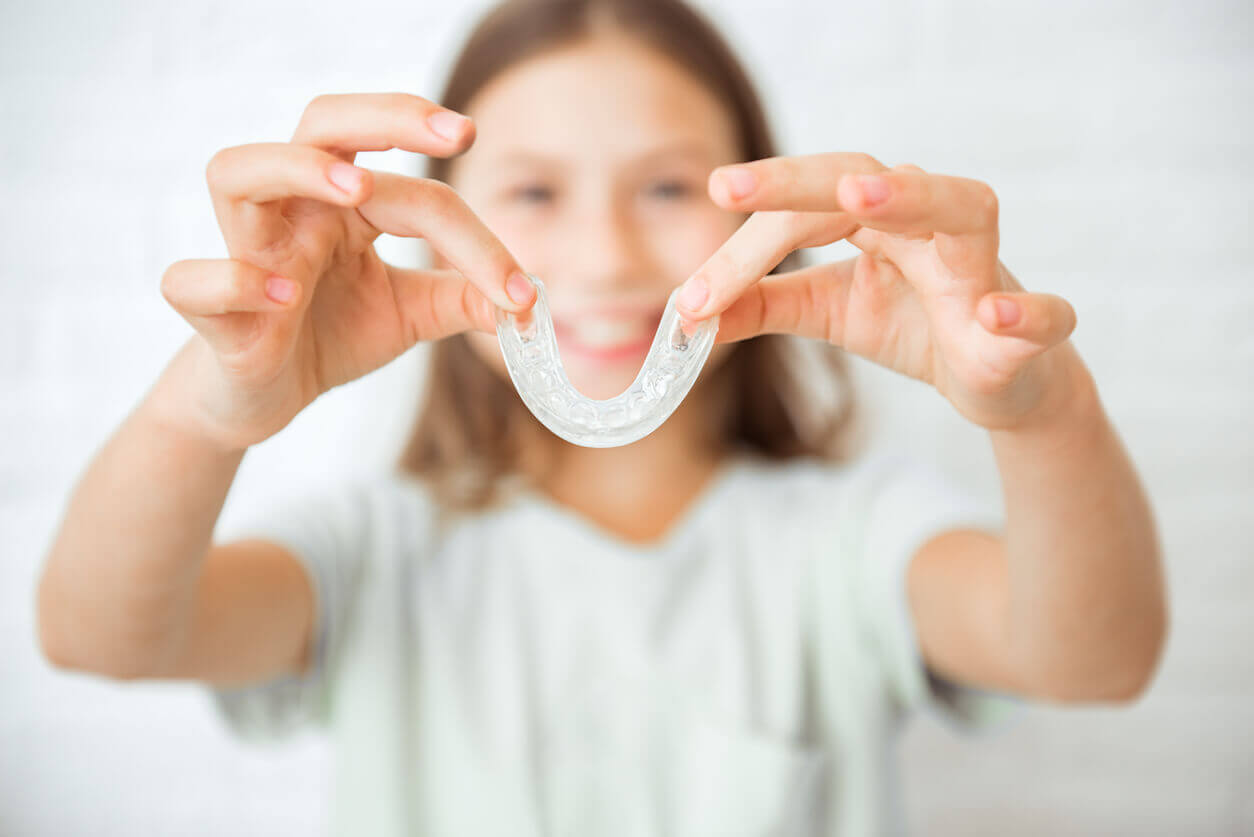My Child's Tooth Has Turned Gray: Why?

In dental consultations, it’s quite common to find parents worried because their child’s tooth has turned gray. And the truth is that the gradual darkening of some dental pieces is a somewhat alarming situation, but also quite common during childhood.
The normal coloration of the dental elements is whitish with very subtle grayish or yellowish tones. But the appearance of a deep gray tooth that gets darker and darker is a wake-up call for parents.
This contrast with the other dental pieces indicates that something isn’t right in that element and a solution needs to be found. Keep reading and find out why your child has a gray tooth and what you should do in this situation.
Reasons why your child’s tooth has turned gray
The color change of your child’s tooth to gray doesn’t happen overnight, but rather occurs progressively. This is because the change in color is the manifestation of slow changes that occur in the internal part of the tooth.
The dental pulp, where the blood vessels and nerves are located, in the center of the tooth, undergoes a necrotic process responsible for the change in color. The lack of irrigation, the exit of red blood cells to the outside, and, in some cases, the colonization of bacteria, cause degeneration and the death of the pulp tissue.
There are several reasons that cause this necrotic process in the pulp and cause the devitalization of dental elements. Although in childhood, the most frequent reasons are trauma and cavities.

Dental trauma
Dental trauma is one of the most common causes of gray teeth in children. We all know that it’s not uncommon for little ones, in their games or while playing sports, to bump their mouths.
At the time of trauma, it may seem that all is well in the mouth. But the irrigation of the dental piece can be interrupted and cause pulpal death. Over time, your child’s bumped tooth may turn gray.
Many times, parents or children don’t even remember the moment when their little one hit their mouth. As we mentioned above, the color change doesn’t happen immediately, but rather 2 or 3 weeks after the blow. For some kids, it can even take months for the traumatized tooth to turn color.
The teeth that turn gray from impact most often are the upper central incisors. Because of their location, they’re the most exposed teeth and with the greatest risk of suffering trauma.
Baby teeth have a higher prevalence of bruise darkening, although the process can affect both dentitions.
Dental cavities
Cavities are one of the most frequent diseases in the entire population. And childhood is a special stage in which the risk of suffering from them is especially high.
Cavities are the destruction of the hard tissues of the dental elements due to the action of acids generated by the bacteria in the mouth. This product of the metabolism of the sugars that we consume by microorganisms is capable of demineralizing the teeth.
The first manifestation of the disorder is spots that start out white and then, as the damage progresses, turn yellow or brown. If the condition isn’t treated, the destruction continues, gaps and breaks appear in the teeth, and the process progresses in depth.
If the decay reaches the pulp of the tooth, it can cause its death. As we already told you, necrosis can be the reason that your child’s tooth turns gray.
A baby tooth with deep caries and pulpal death can cause damage to the dental elements that are forming below. For this reason, it’s essential for children to go to the dentist when you detect a cavity or if you notice that your child’s tooth has turned gray.
What to do if your child’s tooth has turned gray
As soon as you notice that your child has a gray tooth or that it’s changing color, you should seek professional help. A pediatric dentist will be able to evaluate the situation and find the most convenient solution for your case.
When examining the child’s mouth, the dentist will look for other manifestations, such as dental destruction due to cavities, the presence of pus, fistulas, or if the tooth moves. They’ll also inquire about the presence of pain or sensitivity.
If the child has suffered a blow to the mouth, it’s important to let the professional know, specifying when and how the accident happened. You should also let the specialist know if up that moment, the child has had pain, inflammation in the area, or if a pimple of pus appeared on the gum. Taking oral X-rays to control the state of the bone and to know if the permanent teeth have been affected will be necessary.
It will be the particularities of the case that lead the dentist to choose the most appropriate treatment for each child. Their decision will be influenced by the age of the child, the type of dentition affected, the presence or absence of infection, and the severity of the diseases, for example.
In many cases, especially when it’s not long before the baby tooth falls out, the professional suggests staying on the lookout and following up to prevent complications. It’s essential to keep the scheduled appointments to avoid inconveniences.
Other times, you may need to carry out some pulp treatment or the extraction of the baby teeth to give rise to the definitive tooth. If there’s an infection, the use of antibiotics will be appropriate.
If the color change occurs in a definitive piece, special root canal treatments will be necessary, depending on the degree of root formation. When the child is old enough, the aesthetic factor can be solved with veneers or tooth whitening.

The help of a pediatric dentist
The appearance of a gray tooth in your child can often not be prevented. But timely treatment can prevent the process from getting worse.
Taking your child to the pediatric dentist on a regular basis helps to detect any problem that may arise as soon as possible. In addition, with proper dental hygiene and a healthy diet, it will be possible to reduce the risk of cavities.
In the case of injuries, it’s best to provide little ones with mouth guards and avoid dangerous situations that increase the risk of accidents. In any case, if your little one still bumps their mouth, even if everything seems fine, it’s best to visit a trusted dentist. The professional will be able to assess the situation and tell you what to expect and how to promote the recovery of your little one.
With your care and timely professional help, it’ll be easier to keep your child’s mouth healthy and thus decrease the chances of their teeth turning gray.
In dental consultations, it’s quite common to find parents worried because their child’s tooth has turned gray. And the truth is that the gradual darkening of some dental pieces is a somewhat alarming situation, but also quite common during childhood.
The normal coloration of the dental elements is whitish with very subtle grayish or yellowish tones. But the appearance of a deep gray tooth that gets darker and darker is a wake-up call for parents.
This contrast with the other dental pieces indicates that something isn’t right in that element and a solution needs to be found. Keep reading and find out why your child has a gray tooth and what you should do in this situation.
Reasons why your child’s tooth has turned gray
The color change of your child’s tooth to gray doesn’t happen overnight, but rather occurs progressively. This is because the change in color is the manifestation of slow changes that occur in the internal part of the tooth.
The dental pulp, where the blood vessels and nerves are located, in the center of the tooth, undergoes a necrotic process responsible for the change in color. The lack of irrigation, the exit of red blood cells to the outside, and, in some cases, the colonization of bacteria, cause degeneration and the death of the pulp tissue.
There are several reasons that cause this necrotic process in the pulp and cause the devitalization of dental elements. Although in childhood, the most frequent reasons are trauma and cavities.

Dental trauma
Dental trauma is one of the most common causes of gray teeth in children. We all know that it’s not uncommon for little ones, in their games or while playing sports, to bump their mouths.
At the time of trauma, it may seem that all is well in the mouth. But the irrigation of the dental piece can be interrupted and cause pulpal death. Over time, your child’s bumped tooth may turn gray.
Many times, parents or children don’t even remember the moment when their little one hit their mouth. As we mentioned above, the color change doesn’t happen immediately, but rather 2 or 3 weeks after the blow. For some kids, it can even take months for the traumatized tooth to turn color.
The teeth that turn gray from impact most often are the upper central incisors. Because of their location, they’re the most exposed teeth and with the greatest risk of suffering trauma.
Baby teeth have a higher prevalence of bruise darkening, although the process can affect both dentitions.
Dental cavities
Cavities are one of the most frequent diseases in the entire population. And childhood is a special stage in which the risk of suffering from them is especially high.
Cavities are the destruction of the hard tissues of the dental elements due to the action of acids generated by the bacteria in the mouth. This product of the metabolism of the sugars that we consume by microorganisms is capable of demineralizing the teeth.
The first manifestation of the disorder is spots that start out white and then, as the damage progresses, turn yellow or brown. If the condition isn’t treated, the destruction continues, gaps and breaks appear in the teeth, and the process progresses in depth.
If the decay reaches the pulp of the tooth, it can cause its death. As we already told you, necrosis can be the reason that your child’s tooth turns gray.
A baby tooth with deep caries and pulpal death can cause damage to the dental elements that are forming below. For this reason, it’s essential for children to go to the dentist when you detect a cavity or if you notice that your child’s tooth has turned gray.
What to do if your child’s tooth has turned gray
As soon as you notice that your child has a gray tooth or that it’s changing color, you should seek professional help. A pediatric dentist will be able to evaluate the situation and find the most convenient solution for your case.
When examining the child’s mouth, the dentist will look for other manifestations, such as dental destruction due to cavities, the presence of pus, fistulas, or if the tooth moves. They’ll also inquire about the presence of pain or sensitivity.
If the child has suffered a blow to the mouth, it’s important to let the professional know, specifying when and how the accident happened. You should also let the specialist know if up that moment, the child has had pain, inflammation in the area, or if a pimple of pus appeared on the gum. Taking oral X-rays to control the state of the bone and to know if the permanent teeth have been affected will be necessary.
It will be the particularities of the case that lead the dentist to choose the most appropriate treatment for each child. Their decision will be influenced by the age of the child, the type of dentition affected, the presence or absence of infection, and the severity of the diseases, for example.
In many cases, especially when it’s not long before the baby tooth falls out, the professional suggests staying on the lookout and following up to prevent complications. It’s essential to keep the scheduled appointments to avoid inconveniences.
Other times, you may need to carry out some pulp treatment or the extraction of the baby teeth to give rise to the definitive tooth. If there’s an infection, the use of antibiotics will be appropriate.
If the color change occurs in a definitive piece, special root canal treatments will be necessary, depending on the degree of root formation. When the child is old enough, the aesthetic factor can be solved with veneers or tooth whitening.

The help of a pediatric dentist
The appearance of a gray tooth in your child can often not be prevented. But timely treatment can prevent the process from getting worse.
Taking your child to the pediatric dentist on a regular basis helps to detect any problem that may arise as soon as possible. In addition, with proper dental hygiene and a healthy diet, it will be possible to reduce the risk of cavities.
In the case of injuries, it’s best to provide little ones with mouth guards and avoid dangerous situations that increase the risk of accidents. In any case, if your little one still bumps their mouth, even if everything seems fine, it’s best to visit a trusted dentist. The professional will be able to assess the situation and tell you what to expect and how to promote the recovery of your little one.
With your care and timely professional help, it’ll be easier to keep your child’s mouth healthy and thus decrease the chances of their teeth turning gray.
All cited sources were thoroughly reviewed by our team to ensure their quality, reliability, currency, and validity. The bibliography of this article was considered reliable and of academic or scientific accuracy.
- de Jesus Soares, A., Lima, T. F. R., Lins, F. F., Morante, D. R. H., de Almeida Gomes, B. P. F., & de Souza-Filho, F. J. (2011). Un nuevo protocolo de medicación intraconducto para dientes con necrosis pulpar y rizogénesis incompleta. Revista Estomatológica Herediana, 21(3), 145-145.
- Morales Chaucalá, V. A. (2019). Pasta triantibiótica en tratamiento de necrosis pulpar en dientes temporales (Bachelor’s thesis, Universidad de Guayaquil. Facultad Piloto de Odontología).
- Bobadilla, Q., & Paulit, M. (2018). Patologías pulpares más frecuentes en niños con dentición temporal en la Institución Educativa Inicial 001 Niño Jesús de Praga Amazonas, Chachapoyas-2018.
- Páez Félix, Á. E., Cuyutupac Alvarez, A. C., & Poma Valerio, A. S. (2018). Frecuencia de lesiones pulpares en niños y adolescentes de 3 a 16 años, atendidos en la Clínica Dental Docente UPCH, en el período 2015-2016.
- Raposo Correa, S., & Jiménez, P. (2021). NECROSIS PULPAR Y TRAUMATISMOS EN DENTICION TEMPORAL. Revista Europea de Odontoestomatología.
- González Aguirre, L. V. (2020). Revascularización en dientes traumatizados, rizogénesis incompleta y necrosis pulpar (Doctoral dissertation, Universidad Nacional de Cuyo. Facultad de Odontología).
- Pérez Gavica, V. I. (2021). Microbiología de los conductos radiculares en las necrosis pulpares (Bachelor’s thesis, Universidad de Guayaquil. Facultad Piloto de Odontología).
- IPS, P. S. (2018). GUIA CLINICA DE TRAUMA DENTOALVEOLAR.
- Jumbo Jumbo, A. A. (2020). Prevalencia de lesiones pulpares en dientes temporales (Bachelor’s thesis, Universidad de Guayaquil. Facultad Piloto de Odontología).
This text is provided for informational purposes only and does not replace consultation with a professional. If in doubt, consult your specialist.








